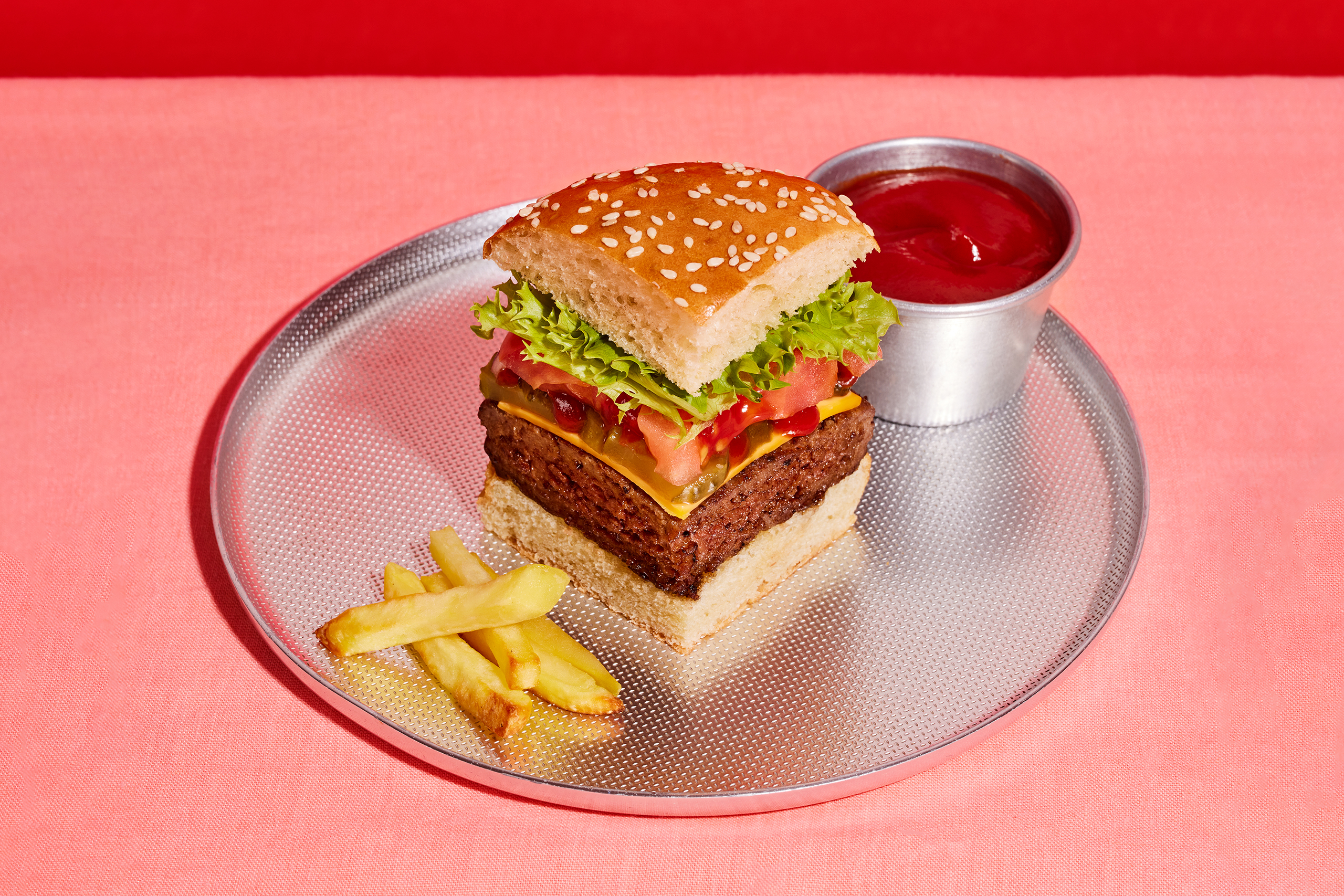Photographs by Ellis Parrinder
It’s 2.53pm on a bright Wednesday afternoon at one of London’s most talked-about new restaurants, and lunch service is finally trickling to a halt. Vast and striking in high-gloss burgundy with a distinctive, 1970s-inspired charm, Town is the new jewel of Covent Garden’s Drury Lane. And, thanks to rave reviews and celebrity sightings (including Gary Lineker and designer Bella Freud), since opening in May, Stevie Parle hasn’t stood still.
A chef and restaurateur with more than two decades of experience, Parle fell in love with providing “escapism via hospitality” at the River Cafe before going on to open a string of restaurants including Joy (sadly, a Covid casualty) and Pastaio, an affordable fresh-pasta restaurant in nearby Soho.
Today, as well-groomed diners linger at sun-dappled tables enjoying the last of their wine, Parle tells me that since opening Town he has seen a shift in how customers are dining. “We had a table of six come in the other day – gen X, probably wealthy. They ordered all the snacks, including three servings of caviar at £100 a pop, and then all the starters, a bottle of champagne and a bottle of wine – which isn’t a lot for a table of six.” He stops and nods at a waiter as two specially designed, bite-sized desserts arrive at our table. “They didn’t have mains, either, and I think probably that’s because they’re taking GLP-1s.”
For the uninitiated, GLP-1s refers to Ozempic (semaglutide) and Wegovy (also semaglutide), and Mounjaro (tirzepatide) – the new breed of drugs that can lead users to lose, on average, between 15% and 20% of their body weight. Rather than simply burning fat, the injectable drugs fundamentally alter how users interact with food and drink by mimicking a naturally occurring hormone called glucagon-like peptide-1. This regulates hunger, slows digestion and sends signals to the brain that suppress appetite and increase feelings of fullness.
Here in the UK, the possible impact of such drugs is enormous. Weight-loss medications are available to up to 220,000 patients via the NHS but most are currently obtained through private prescription services – in total about 1.5 million people across the country.
However, its potential user base is far greater; NHS England estimates that 2.8 million people would be eligible to use Mounjaro were it more readily available, and research by market intelligence company Mintel shows that a quarter of UK adults are currently interested in using weight-loss drugs.
What semaglutide and tirzepatide are designed to do correlates with what Parle is seeing at Town, as well as within his social network. “A few of my friends are taking it, and they’re not finishing their food. Normally, I’d be like, ‘Oh, what’s wrong with it?’ But they’re just not eating as much as they used to.” One 12‑week assessment of patients concluded that participants consumed 24% fewer calories per day, while research by Morgan Stanley found that users consume 62% less alcohol, with 22% saying they stopped drinking entirely.
According to Dan Hastings-Narayanin at trend forecasting agency the Future Laboratory, if the uptake of weight-loss drugs continues to increase as predicted – and appetite itself becomes increasingly medically muted – widespread change is inevitable. “It’s not a prediction; this is already happening,” he says. “The rise of GLP-1 weight-loss drugs is already reshaping the food and drink industries, with restaurants and bars among the sectors most likely to feel the impact.”
‘Most tend to order sharing dishes and leave their companions to eat most of the food’
Jennifer Creevy at trend forecaster WGSN has been monitoring the fallout closely. “Here in the UK, [chefs] are seeing more food being left on the plates and returned to the kitchen, fewer dessert orders, and many diners foregoing or cutting down on alcohol.” Despite the general consensus among food reporters that the average UK restaurant-goer has “fallen out of love” with small plates, for those on weight-loss drugs the opposite is true. “Most tend to order sharing dishes and leave their companions to eat most of the food,” Creevy says.
This is something that Harriet* knows all too well. A self-confessed “foodie” who spends a large amount of her disposable income on food, she has lost more than two stone on tirzepatide over the past six months. “I am obsessed with keeping on top of what’s new in the London restaurant scene, but the way I eat and how often I eat has changed so much. I still love dining out for the social aspect of things, but these days I do it far less.
“Sharing plates are ideal, especially when I don’t want to tell people I’m on Mounjaro, because I don’t have to leave anything half eaten.” What’s more, Harriet says she prefers “quality over quantity – more protein and fresh produce, as well as better quality wine and cocktails”.
Restaurant PR executive Siobhan*, who has been taking semaglutide for four months, shared a similar experience. “My job involves a lot of eating and drinking at bars and restaurants, which is a challenge because I don’t crave rich, heavy, indulgent food any more. Small plates mean I can get away with eating much less.” Nevertheless, she makes fewer bookings on her own time. “For the first time in years I’ve started saving money because when I’m not dining out for work, I tend not to go out as much.”
Another benefit, she adds, is an improved relationship with alcohol. “I used to binge drink. I’d knock back pretty much anything I could get my hands on. Now, I’m much more considered when it comes to alcohol. When I do drink, it’s a small amount of something really good.”
According to Toby Clark, vice-president of consulting at Mintel, the chefs who have noticed a change in their customers tend to be operating at higher price points. “There are two big factors in the UK which are limiting the impact of the drugs at the moment,” says Clark. “One is that it’s hard to get, the other is that if you can get a private prescription, it’s expensive, so that instantly limits the kind of people that are able to afford it.”
It's something Dom Hamdy, the restaurateur behind Bistro Freddie and Crispin in Shoreditch, and Canal in Westbourne Park, has noticed. “I’ve spoken to different restaurateurs, and it seems to be the restaurants in wealthy areas that are seeing more of an effect. It’s an expensive drug and it will be more widely used in wealthier circles, so restaurants in Mayfair, for example, are feeling the effects far more than where we sit in the market.”
Likewise, Parle hasn’t seen any changes in how customers are dining at his more casual pasta restaurant, Pastaio. “It’s a slightly different demographic … I think at the moment people taking GLP-1 in this country are wealthy, because it’s difficult to get it on the NHS.” At Town, “a much more expensive restaurant” catering to the “west London liberal elite”, the effects are more noticeable.
If we want to see what might happen to the UK hospitality industry – especially in major cities – should the NHS increase supply, keeping an eye on what is happening in the US is key, says Clark. “They are significantly further ahead than most European markets when it comes to the use of these GLP-1 drugs, so we can see how trends play out over there.”
According to one former restaurant owner in the US, the impact has already been devastating. Michelle Bonds sparked conversation in January when she put the closure of her Dallas bar and eatery, Trova Wine and Market, down to the arrival and widespread adoption of weight-loss drugs. In New York, many restaurants are adapting to meet demand. Clinton Hall in midtown Manhattan has begun offering a “teeny-weeny mini meal”, while nearby restaurants The Noortwyck, L’Abeille and Coqodaq now serve hyper-luxurious, bite-sized portions. At a hospitality conference last month, the co-owner of a European restaurant group, who declined to comment for this article, expressed concern for his businesses after trips to Miami and California, where the impact of weight-loss drug usage on restaurants was frighteningly evident to him.

Town's Nikka Whisky Kashi.
Parle is one of the first UK chefs to take action. “What I really want to do with Town in particular is allow people to have what they want,” he says. “So, if I need to evolve my menu a little bit to make sure there are two sizes of things, or some tiny desserts, or lower ABV drinks, then of course that’s what I should do, because that’s hospitality and that’s the whole point. Being resistant to change is not going to help us.” At Town, his menu offers a 200g steak, as well as decadent “half-sized” chocolate tart with black barley ice-cream, sherry-soaked raisins and hazelnuts, and a bite-sized Nikka whisky kashi, which resembles a square canelé.
Rohit Ghai, chef-patron of high-end Indian restaurants Kutir and Vatavaran, has also made changes to his menus. “I still want people to enjoy the social experience of dining out,” he says, “so we have adapted to offer bar snacks and drinks for people who might not want a full meal or have a reduced appetite for various health and social reasons. We also have optional sides for people who may just want to enjoy a main protein option with reduced carbohydrates.”
Hamdy, who recently introduced the “table cheeseburger” at Canal, cut into four for an “indulgent fix rather than as an entire main”, is not averse to adapting either. “Restaurants are not just about the food, they’re entertainment spaces, they’re social spaces. If there is a need to adapt and change the way that menus are written, it will have to happen. Restaurants that are unwilling to adapt will fall by the wayside.”
Nima Safaei, chef and owner of Soho’s 40 Dean Street, is considering altering his menus too, though he warns of potential price hikes which could alienate some customers.
‘Smaller portions and fewer portions simply mean less money for restaurants and it may mean we need to increase prices’
Nima Safaei, chef and restaurateur
“Smaller portions and fewer orders simply mean less money for restaurants, and it may mean that we have to increase prices to maintain profit margins.”
Restaurants and pubs have long been treasured as vehicles for human connection, so what would happen to them if, for many, eating and drinking is off the menu?
Clark believes we could see an increase in activity-based drinking and dining. “One thing we’ve seen at Mintel over the past five years is the rise of competitive socialising – places like [digital darts destination] Flight Club.
“If the number of GLP-1 users increases significantly in the UK you can see the trend accelerating for social activities that don’t revolve entirely around food or alcohol.”
Following the rise in popularity of running clubs and social saunas, nutrition-focused spaces could also thrive. Former financier Julia Baldet, who recently launched “functional smoothie bar” Elevate – touted as “London’s answer to Erewhon”, the zeitgeisty, California supermarket known for its expensive, celebrity-endorsed health foods – has noticed a surge of interest from customers she suspects are using weight-loss drugs. “There has been a huge push recently for high-protein products for multiple reasons and a lot of it is tied to GLP-1 drugs.”
According to doctors and nutritionists, eating more protein helps users lose fat instead of muscle and – because protein-rich foods are naturally higher in essential vitamins and minerals – stay nutritionally balanced while eating less overall. “No one comes into the store and tells me, ‘I’m taking semaglutide,’ because they still think it’s a taboo topic, but our second-best seller is a protein shake.”

So will we truly see a major change in food culture in the UK?
According to Clark, the rise of weight-loss drugs is happening alongside other complementary trends, such as lower alcohol consumption and a 10-year increase in higher-protein products, which makes it difficult to tell. Nonetheless, he continues, “These big societal shifts are like oil tankers. They take a long time to get up to speed, but once they do, they’re really hard to turn around.”
According to Safaei, there is no going back. “It already has impacted the industry. It’s therefore up to us to find a way to accommodate customers, rather than deterring them from going out altogether.”
Still, Harriet and Siobhan say they have no intention of giving up dining out entirely. “I’d like to see more places have smaller portions available, but realistically I’m a sucker for what’s trending, so I’ll always want to check out new restaurants,” says Harriet.
“And is there any better way to gossip with friends than over dinner and martinis? I’ll just make my martini a mini one.”
Prop styling: Ellis Parinder. Food styling: Sarah Hardy. Hand model: Sophie Fryer
